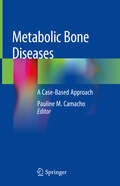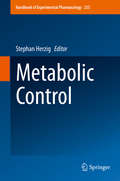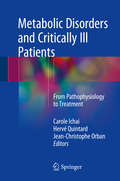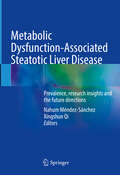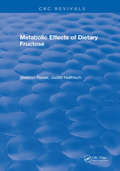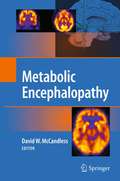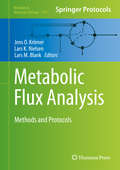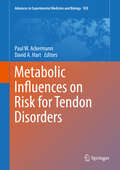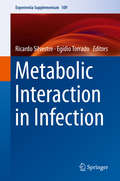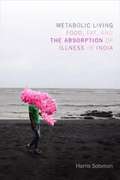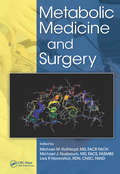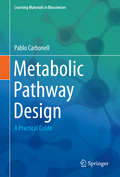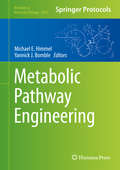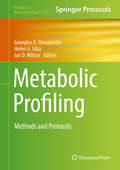- Table View
- List View
Metabolic Bone Diseases: A Case-Based Approach
by Pauline M. CamachoThis concise, case-based text discusses the current state of the art for the diagnosis and management of metabolic bones diseases. Each chapter opens with a unique case presentation and utilizes a consistent format that includes relevant anatomy, physiology, and pathophysiology as well as examination, treatment approaches and clinical outcomes. Topics covered include osteoporosis, rickets and osteomalacia, hypoparathyroidism and pseudohypoparathyroidism, osteogenesis imperfecta, Paget's disease of bone, calcium and phosphorous disorders, hypophosphatasia, sclerotic bone disorders, fibrous and osteochondroplasia, and other malignancies of bone. Written and edited by experts in the field, Metabolic Bone Diseases is a valuable resource for practicing endocrinologists, rheumatologists and orthopedic surgeons, residents and fellows.
Metabolic Control
by Stephan HerzigThe HEP issue on Metabolic Control provides a state-of the art overview over both classical concepts and emerging areas in metabolism and associated disorders. In this context, metabolic control is highlighted at various levels of complexity ranging from transcriptional mechanisms in metabolic pathway control over metabolic communication routes in physiology and pathophysiology to current treatment modalities and options in metabolic disorders, including type 2 diabetes and obesity. Dedicated chapters by leading experts in their fields provide a concise overview over important areas in metabolic research at a molecular level, including the role of the central nervous system in metabolism, inflammation and metabolism, pancreatic hormone signaling, brown adipose tissue, and therapeutic concepts.
Metabolic Disorders and Critically Ill Patients
by Carole Ichai Hervé Quintard Jean-Christophe OrbanThe purpose of this book is to bring together the latest findings on metabolic disorders that are strongly implicated in various critically ill patients. Since the beginning of the 20th century, maintaining the "milieu int#65533;rieur" has been a major challenge for intensivists. In addition to considerable technological developments in intensive care units, important advances in our understanding of metabolic disorders observed in critically ill patients have been made during the 10 last years. Today, the intensivit can't ignore these disorders when selecting the most appropriate treatment for an illness. Cellular metabolic abnormalities are responsible for systems and organ failures, so the modern approach of organ dysfunctions now includes prevention or treatment of such disorders. This book is a comprehensive tool, allowing the physician to understand, diagnose and treat these metabolic disorders. Water, electrolyte, acid-base, glycemic and endocrinologic problems, as well as metabolic abnormalities observed in renal, cerebral and hepatic failure are presented in different chapters. The last part of the book is devoted to modern nutritional concepts, the consequences of energy modifications, mitochondrial dysfunction, hypothermia, oxidative stress and ischemia reperfusion, which open the way for new therapies.
Metabolic Dysfunction-Associated Steatotic Liver Disease: Prevalence, research insights and the future directions
by Xingshun Qi Nahum Méndez-SánchezThis book provides crucial insights into the most recent advancements in understanding pathophysiology of Metabolic Dysfunction-Associated Steatotic Liver Disease (MASLD), and presents innovative treatment approaches. The emerging areas of study and potential avenues for further investigation are discussed in chapters. Additionally, the latest information on diagnostic tools, lifestyle interventions, and pharmacological treatments is also presented. With the worldwide prevalence of MASLD on the rise, it helps to equip medical professionals (hepatologists, gastroenterologists, endocrinologists, cardiologists, nephrologists, internists, and surgeons), researchers, and patients with up-to-date knowledge to effectively combat this multifaceted condition.
Metabolic Effects Of Dietary Fructose
by Sheldon ReiserIt is hoped that the material presented in this book will provide the reader with a detailed description of the published research pertaining to the metabolic effects of dietary fructose, will define future research needs, and will stimulate interest in further research aimed at evaluating the advisability of the intake of fructose by humans.
Metabolic Encephalopathy
by David W. MccandlessMetabolic Encephalopathy is meant to combine and correlate animal and human studies. It is hoped that increased awareness of the importance of early diagnosis and treatment of these disorders may result in a lowering of the incidence of structural changes and morbidity. These disorders hold a special fascination for both basic scientists and clinical investigators because they are accessible, treatable and there exists good animal models for study. Therefore, this book will pull together basic and clinical neuroscience issue in the treatment of specific metabolic encephalopathies.
Metabolic Flux Analysis
by Jens O. Krömer Lars K. Nielsen Lars M. BlankMetabolic Flux Analysis: Methods and Protocols opens up the field of metabolic flux analysis to those who want to start a new flux analysis project but are overwhelmed by the complexity of the approach. Metabolic flux analysis emerged from the current limitation for the prediction of metabolic fluxes from a measured inventory of the cell. Divided into convenient thematic parts, topics in this essential volume include the fundamental characteristics of the underlying networks, the application of quantitative metabolite data and thermodynamic principles to constrain the solution space for flux balance analysis (FBA), the experimental toolbox to conduct different types of flux analysis experiments, the processing of data from 13C experiments and three chapters that summarize some recent key findings. Written in the successful Methods in Molecular Biology series format, chapters include introductions to their respective topics, lists of the necessary materials and reagents, step-by-step, readily reproducible protocols and notes on troubleshooting and avoiding known pitfalls. Authoritative and easily accessible, Metabolic Flux Analysis: Methods and Protocols presents protocols that cover a range of relevant organisms currently used in the field, providing a solid basis to anybody interested in the field of metabolic flux analysis.
Metabolic Influences on Risk for Tendon Disorders
by Paul W. Ackermann David A. HartThis book will be of considerable interest to students, practitioners (Doctors, Physiotherapists) and researchers who deal with the complex structures of tendons and tendon disorders. The book is divided into three sections: (1) Basic Biology; (2) Metabolic Disorders; and (3) Biochemical Markers and Tendon disorders. The first section, devoted to the basic biology of tendons, is aimed at those people who want to learn and gain basic information on tendons. The section on metabolic disorders will mainly be aimed at practitioners who need to know how to treat their patients. Finally, the section on biochemical markers is chiefly aimed at the researchers who are planning new studies within this field.
Metabolic Interaction in Infection (Experientia Supplementum #109)
by Ricardo Silvestre Egídio TorradoThis book focuses on host–pathogen interactions at the metabolic level. It explores the metabolic requirements of the infectious agents, the microbial metabolic pathways that are dedicated to circumvent host immune mechanisms as well as the molecular mechanisms by which pathogens hijack host cell metabolism for their own benefit. Finally, it provides insights on the possible clinical and immunotherapeutic applications, as well as on the available experimental and analytical methods. The contributions break new ground in understanding the metabolic crosstalk between host and pathogen.
Metabolic Living: Food, Fat, and the Absorption of Illness in India
by Harris SolomonThe popular narrative of "globesity" posits that the adoption of Western diets is intensifying obesity and diabetes in the Global South and that disordered metabolisms are the embodied consequence of globalization and excess. In Metabolic Living Harris Solomon recasts these narratives by examining how people in Mumbai, India, experience the porosity between food, fat, the body, and the city. Solomon contends that obesity and diabetes pose a problem of absorption between body and environment. Drawing on ethnographic fieldwork carried out in Mumbai's home kitchens, metabolic disorder clinics, food companies, markets, and social services, he details the absorption of everything from snack foods and mangoes to insulin, stress, and pollutants. As these substances pass between the city and the body and blur the two domains, the onset and treatment of metabolic illness raise questions about who has the power to decide what goes into bodies and when food means life. Evoking metabolism as a condition of contemporary urban life and a vital political analytic, Solomon illuminates the lived predicaments of obesity and diabetes, and reorients our understanding of chronic illness in India and beyond.
Metabolic Medicine and Surgery
by Michael M. Rothkopf Michael J. Nusbaum Lisa P HaverstickThe first comprehensive overview of an emerging field, Metabolic Medicine and Surgery introduces a new paradigm in patient management that crosses existing subspecialty boundaries. This approach is necessitated by the challenges of treating patients with obesity, metabolic syndrome, cardiovascular disease and prediabetes, as well as those with mald
Metabolic Pathway Design: A Practical Guide (Learning Materials in Biosciences)
by Pablo CarbonellThis textbook presents solid tools for in silico engineering biology, offering students a step-by-step guide to mastering the smart design of metabolic pathways. The first part explains the Design-Build-Test-Learn-cycle engineering approach to biology, discussing the basic tools to model biological and chemistry-based systems. Using these basic tools, the second part focuses on various computational protocols for metabolic pathway design, from enzyme selection to pathway discovery and enumeration. In the context of industrial biotechnology, the final part helps readers understand the challenges of scaling up and optimisation. By working with the free programming language Scientific Python, this book provides easily accessible tools for studying and learning the principles of modern in silico metabolic pathway design. Intended for advanced undergraduates and master’s students in biotechnology, biomedical engineering, bioinformatics and systems biology students, the introductory sections make it also useful for beginners wanting to learn the basics of scientific coding and find real-world, hands-on examples.
Metabolic Pathway Engineering (Methods in Molecular Biology #2096)
by Michael E. Himmel Yannick J. BombleThis book illustrates experimental and computational methodologies used to achieve cost effective biological processes for the production of fuels and biochemicals through multiple approaches to increasing yield, titers, and productivity in a robust host. The volume includes the most recent and cutting-edge aspects of pathway engineering, flux analysis, and metabolic enzyme engineering. Each chapter highlights the complexity and challenges of the problem as well as the methods used to solve this problem or changes needed in current methods. As a part of the highly successful Methods in Molecular Biology series, chapters include the kind of detailed implementation advice that gives researchers a much needed boost. Authoritative and practical, Metabolic Pathway Engineering benefits not only scientists working on more fundamental aspects of this endeavor but also those in the biochemical industry working on strain engineering for robust industrial processes.
Metabolic Profiling: Methods And Protocols (Methods In Molecular Biology #1738)
by Ian D. Wilson Georgios A. Theodoridis Helen G. GikaThis volume explores the different approaches and techniques used by researchers to study the recent challenges and developments in metabolic profiling. This book is divided into IV parts. Part I contains chapters that highlight basic concepts, such as experimental design, data treatment, metabolite identification, and harmonization. Part II describes experimental protocols for both targeted and untargeted metabolomics covering the basic analytical technologies: LC-MS, GC-MS, NMR and CE-MS. In addition the protocols describe methods for the study of tissues, feces, blood and other types of biological samples as well as the application of chemical derivatization for GC-MS. Parts III and IV present the use of metabolomics in the study of food, plants and the life sciences, with examples from the quest for the discovery of disease biomarkers, physical exercise omics and metabolic profiling of food, fruit and wine. Written in the highly successful Methods in Molecular Biology series format, chapters include introductions to their respective topics, lists of the necessary materials and reagents, step-by-step, readily reproducible laboratory protocols, and tips on troubleshooting and avoiding known pitfalls.Authoritative and thorough, Metabolic Profiling: Methods and Protocols is a valuable resource for researchers who are interested in expanding their knowledge of this rapidly developing field.
Metabolic Regulation in Mammals (Lifelines Series)
by David Gibson Robert A. HarrisMetabolic Regulation in Mammals presents the basic principles of metabolic control, based on investigations conducted during the past 20 years. It explains the impact of recent advances in cell biology, molecular biology, and genetics on the field. This text covers all angles of metabolic regulation, including blood caloric homeostasis, cardiac and skeletal muscle, adipose tissue, and liver metabolism. Review questions, summary sections, and worked examples help break down the complexity of the subject, and details of metabolic pathways are provided for each body system, along with accompanying charts. This text is ideal for undergraduates in biological and health science disciplines.
Metabolic Regulation: A Human Perspective (Frontiers In Metabolism/neurobiology Ser. #No. 1)
by Keith N. FraynThe important Third Edition of this successful book conveys a modern and integrated picture of metabolism and metabolic regulation. Explaining difficult concepts with unequalled clarity, author Keith Frayn provides the reader with an essential guide to the subject. Covering topics such as energy balance, body weight regulation and how the body copes with extreme situations, this book illustrates how metabolic regulation allows the human body to adapt to many different conditions. Changes throughout the new edition include: Extensive chapter updates Clear and accessible 2-color diagrams Q&A sections online at www.wiley.com/go/frayn to facilitate learning Frayn has written a book which will continue to be an extremely valuable tool for scientists, practitioners and students working and studying across a broad range of allied health sciences including medicine, biochemistry, nutrition, dietetics, sports science and nursing.
Metabolic Response of Slowly Absorbed Carbohydrates in Type 2 Diabetes Mellitus
by Meidjie AngThis SpringerBrief focuses on clinical nutrition research, particularly on the effects of slowly absorbed carbohydrates on postprandial glucose metabolism in type 2 diabetes. Slowlyabsorbed carbohydrates will cause gradual increases in blood glucose and insulin levels, and may therefore be effective as part of a treatment strategy for glycemic control and reduction of cardiovascular complications in type 2 diabetes.
Metabolic Risk for Cardiovascular Disease
by Robert H. EckelThe relationship of metabolic diseases to cardiovascular disease (CVD) is reaching epidemic proportions. This relates mostly to the increasing prevalence of obesity, the metabolic syndrome and type 2 diabetes.This book outlines and addresses the metabolic factors and related diseases that contribute to CVD, including brief introductions to metabolic pathways including lipid and lipoprotein metabolism, macronutrient fuel partitioning, insulin action and body weight regulation. Mechanisms that relate to becoming obese, maintenance of the obese state, the dyslipidemias, and glucose intolerance/diabetes are also addressed, and the importance of interventions that reduce metabolic risk factors and CVD are covered.
Metabolic Structure and Regulation: A Neoclassical Approach
by Raymond S. OchsThere is a renewed interest in the fundamentals of energy metabolism, yet most people base their understanding on the views of generalists expressed in elementary textbooks. New techniques that enable analysis of thousands of metabolites provide useful data, but do not themselves substitute for an understanding of the fundamentals of metabolism. While classical ideas of metabolism are also valuable, some earlier ideas have not withstood further investigation. This book presents a personal philosophy but rests on what is broadly accepted by metabolic biochemists over the past few decades.
Metabolic Syndrome
by Akhlaq A. FarooquiMetabolic syndrome as an important risk factor for stroke, Alzheimer disease, and depression presents readers with cutting edge and comprehensive information on relationship among metabolic syndrome, stroke, Alzheimer disease, and depression. It is hoped that this monograph will be useful to postgraduate students, faculty, research scientists, pharmacologists, nutritionists, and physicians, who are curious about the molecular mechanisms that link metabolic syndrome with stroke, Alzheimer disease, and depression.
Metabolic Syndrome
by Minghan WangThis book provides a comprehensive overview of the development of metabolic syndrome, the underlying mechanisms and therapeutic strategies for drug development. The authors examine the context of underlying molecular pathways and integrated physiology, then expanding the discussion to diseases associated with metabolic syndrome. The development of drug therapies for these diseases and complications is extensively covered. The book offers a comprehensive and in-depth view of energy metabolism, metabolic tissues and pathways, molecular mechanism-based drug discovery and clinical implications.
Metabolic Syndrome
by Rexford S. AhimaThis comprehensive reference work edited by one of the leading authorities on obesity presents an up-to-date survey of the current scientific understanding of the metabolic syndrome, as well as an overview of the most significant changes to the field over the past 30 years. This volume is a thorough reference for obesity and the metabolic syndrome and will prove an indispensable resource for clinicians and researchers at levels worldwide. The obesity epidemic has generated immense interest in recent years due to the wide-ranging and significant adverse health and economic consequences that surround the problem. Much attention has been focused on behaviors that lead to obesity, in particular to over consumption of energy-dense food and to sedentary lifestyle. However, obesity is an extremely complex condition with poorly defined pathogenesis. In addition, when combined with other comorbidities such as hypertension and dyslipidemia, obesity often leads to a patient diagnosis of metabolic syndrome, a very troubling condition that has grown, and is continuing to grow, rapidly each year in prevalence worldwide. Metabolic syndrome is a cluster of conditions -- increased blood pressure, a high blood sugar level, excess body fat around the waist and abnormal cholesterol levels -- that occur together, increasing one's risk of heart disease, stroke and diabetes. This resource covers the full range of scientific and clinical aspects: epidemiology, genetics, environmental factors, pathophysiology, diseases associated with obesity, and clinical management.
Metabolic Syndrome and Cardiovascular Disease
by T. Barry Levine Arlene Bradley LevineTrends indicate that the metabolic syndrome will become the leading risk factor for heart disease. Now more than ever you need an all-in-one reference that provides the tools and practical advice you need to: Identify at-risk patients Explain individual contributing factorsAid in patient education and motivationDirect comprehensive care and Choose the most appropriate interventions Comprehensively revised to reflect leading-edge research and now organized to facilitate easy access to essential information and clinically-relevant guidance," Metabolic Syndrome and Cardiovascular Disease, 2e" offers this and more. Not only will you receive a solid understanding of the pathophysiology underlying the metabolic syndrome and cardiovascular disease "but also" the rationale for todayOCOs most effective treatments. WhatOCOs new?Filled with timely new content, this updated edition covers: New discoveries that have changed our understanding of the pathogenesis and interrelationship of metabolic syndrome, cardiovascular disease (CHD), and type 2 diabetes mellitus (DM) The relevance of mitochondria and telomeresSleep and its impact on cardiometabolic healthThe pivotal interplay between insulin and forkhead transcriptionfactors Calorie restriction research Bariatric surgery experiences and outcomesIn addition, each chapter includes essential information on comorbidities, interventions, and pharmacotherapeutic options OCo an exclusive feature found only in the second edition "
Metabolic Syndrome and Cardiovascular Disease: Epidemiology, Assessment, and Management
by Andrew J. Krentz, MD, FRCPAddressing a topic of utmost importance in the field, this text addresses the epidemiology, diagnosis, assessment, and management of patients with metabolic syndrome-focusing on implications for cardiovascular disease risk. With an abundance of clearly organized tables, flowcharts, and practice guidelines, this blue-ribbon source succinctly analyze
Metabolic Syndrome and Complications of Pregnancy
by Barry Sears Enrico FerrazziThis book explores the nature of pregnancy and metabolic syndrome as proinflammatory conditions and explains how pregnancy provides a window of opportunity for preventing the lifelong complications of metabolic syndrome, during which key risk factors can be identified and beneficial dietary changes can be implemented. The book's opening sections discuss inflammation in the context of pregnancy, including the nature of the placenta as a proinflammatory tissue. In the main body, it points to new possible connections to truncal obesity, inflammation, metabolic syndrome, and major obstetrical syndromes, including preeclampsia, gestational diabetes and pre-term delivery. Based on the insights offered by this analysis, the remainder of the book focuses on a variety of nutritional measures and diets that can be of benefit during and beyond pregnancy. Readers will learn how the higher level of compliance with medical instructions during pregnancy can be capitalized on to ensure enduring health benefits for mother and child alike.
